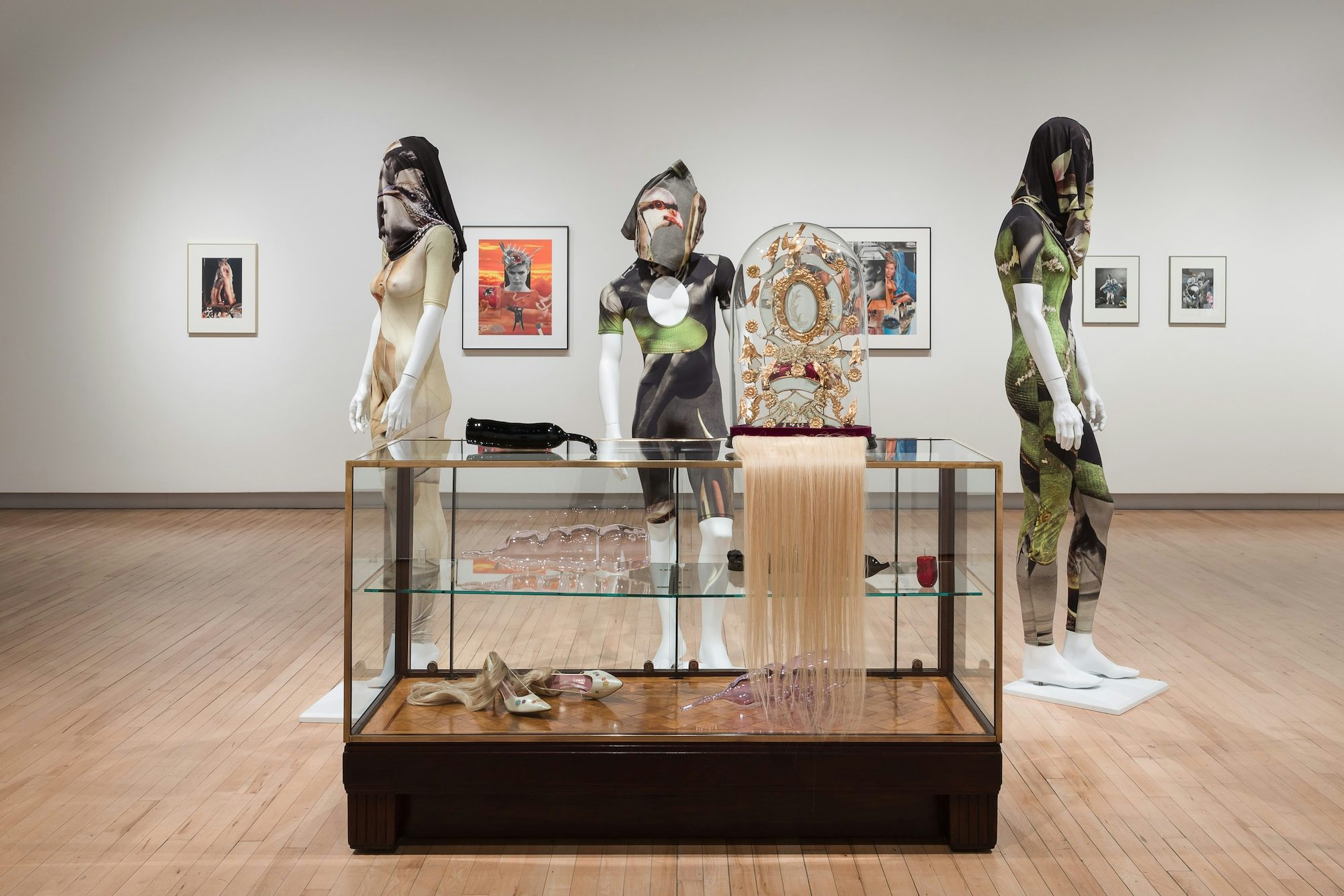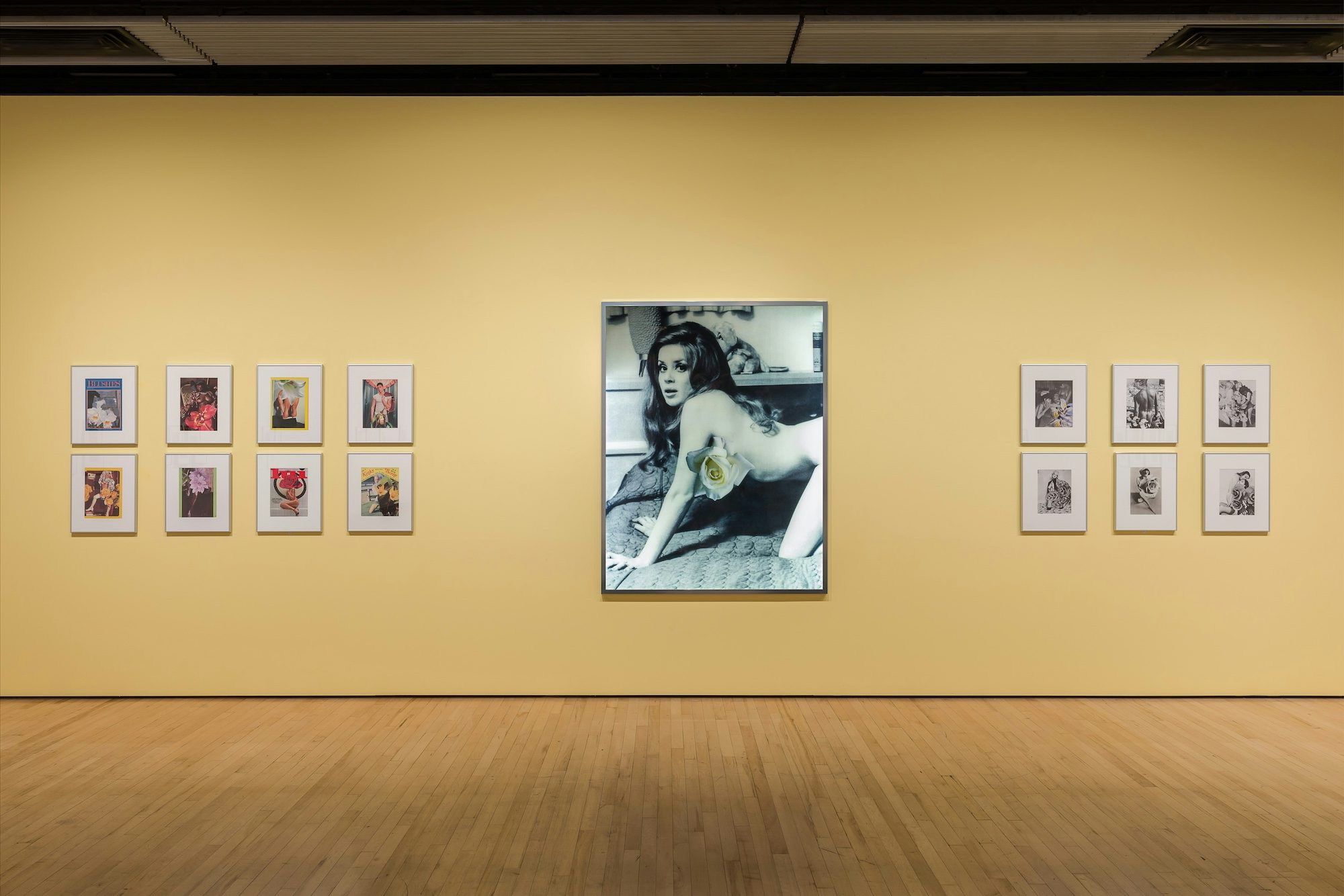Inside Linder’s Hayward Gallery show
An overdue London retrospective, aptly titled Danger Comes Smiling, shows the 70-year-old artist’s work and ideas are still sharp to the touch
Entering Linder: Danger Came Smiling, the retrospective of the Liverpool-born artist now open at London’s Hayward Gallery, you are stared down by Linder herself. In a wall-height photographic portrait, the artist appears dressed in pearls and gagged by cellophane, contradictions which her eyes, lined and mascara’d, dare you to understand.
It is a fitting introduction to the multidisciplinary artist, who, now aged 70, has never been a retiring figure. Real-name Linda Sterling, she has had a 50-year career working across music, film, textiles, fashion and performance. Her work is frequently confronting, such as a 1982 performance at the Haçienda in Manchester with her band Ludus where she wore a dress made of meat – long before Gaga, and paired with a large black dildo. But she is best known for her photomontages made with magazine imagery, where decisive cuts, made with a surgical scalpel, unsettlingly skewer the status quo.
Those unfamiliar with Linder’s name may have seen her most famous work for the cover of Buzzcocks’ 1977 debut single Orgasm Addict, designed by Malcolm Garrett. It features an oiled-up female torso, domestic iron for a head, with two smiling, lipsticked mouths in place of nipples (“Look into my iron and tell me you want me,” they challenge). This work came early in her career; moving to Manchester to study graphic design, Linder soon discovered punk, attending the Sex Pistols’ infamous 1976 show at Manchester’s Lesser Free Trade Hall.

She found her place in that scene, then in post punk after, and vitrines in the exhibition record her contributions: linoprints of punk icon Jordan; a zine made with Jon Savage called The Secret Public; images of Linder performing with Ludus; as well as album covers and posters she made for Buzzcocks, Magazine, and Joy Division. An illustrated artwork for Ludus’ second album, Danger Came Smiling, shows where the exhibition gets its name – and offers the warning that exists throughout her work.
In the 1970s of her youth – inspired by punk’s ethos and methods as well as feminist writings and the work of German dadaist Hannah Höch – Linder recognised danger in the firmly gendered landscape. Seeing this reflected in, and enhanced by, the print media, where magazines offered women self- and home-improvement (via fashion, makeup and domestic goods), and men the promise of pleasure (through consuming sport, cars, goods and women’s bodies), she used the power of these images against them – using scalpel and glue to rig the game on her terms.
The cuts made by my blades and scissors are perpetually liberating. Each restores agency across print and page
On nameless nudes, heads are substituted for domestic devices, sometimes with newly unbalanced eyes and smiles. Magazine images are rendered comic, grotesque, or simply transparent: one naked woman is bound by string as a sexual practice yet wedged in a saucepan like a joint of meat; a picture-perfect young couple are shown in each other’s arms, the woman’s hand simultaneously clasping her beau’s shoulder while manoeuvring an oversized fork to gouge out her own eyes. Both women are smiling.
Source imagery ranges from the obviously violent (pornography) to the seemingly benign (consumer magazines and fairytales), but Linder uses what she describes as a “forensic” approach to dissect and reconstruct.

Curated by Hayward’s Roden chief curator Rachel Thomas and assistant curator Gilly Fox, the exhibition is arranged across four rooms. Photomontages line the walls; at magazine scale, they invite close looking, rewarded by the discovery of each plot twist made by knife. The centres of the rooms feature larger works from across Linder’s practice – some more engrossing than others.
A video shows Linder bodybuilding and is curiously spellbinding as you watch her complete sets in a gym lit like a nightclub. Another installation features a spiral rug made with Edinburgh’s Dovecot studios – dotted with eyes with long tufted lashes – in reference to British occultist artist Ithell Colquhoun. Elsewhere are three mannequins dressed in ballet costumes made by the late fashion designer Richard Nicoll. Both have been activated in dance performances but lack some action here.
While the sexualised imagery she often worked with enjoyed the euphemistic title ‘glamour photography’, Linder wants to reclaim the word’s 18th century sense, where ‘to cast a glamer’ referred to witches’ enchantments. From her own lifetime, she finds agency in the glamming up of the northern working-class women she grew up around, as well as at drag nights she attended in Manchester and Salford pubs during the 70s. A brief and tender series of photographs she made of these performers is included in the exhibition.

Working now from a studio in Lancashire, she emerges as a witch herself, or a kind of Robin Hood figure, using violent means to good ends. “The cuts made by my blades and scissors are perpetually liberating. Each restores agency across print and page,” Linder says. “The found images in my work are often quite fragile both materially and conceptually, it doesn’t take much then to hijack them and to take them somewhere far more surreal.”
At times she forgoes her scalpel for softer tools. When caring for her dying father, she had to spoon feed him soft foods, crossing new boundaries in their relationship. Having recently discovered sploshing – a fetishistic practice that involves covering the body in soft foods and other substances – Linder photographed her and a friend performing it. It’s much messier and less precise than her other images, reflective of the unresolvable proposition that caregiving is.
Some photomontages of shells and ballet dancers provide soothing imagery from her childhood which helped as she grieved the loss of her parents, while a montage from 2021, The Pool of Life, features wordplay in reference to Liverpool and is a nourishing repository of the images to which she frequently returns.

You might expect that 50 years on the works might fail to land, but their meaning remains recognisable, despite decades of societal progress. Today’s methods of manipulation, made mainstream by tech, offer new resonance for the collaged works: the 25 variations on a portrait of a woman, montaged with different ill-fitting lips, might read more like a camera roll of self-filtering and modifying today.
Meanwhile a new work references the deep fake, used to malevolent ends in AI-powered revenge porn. Featuring her own face – obviously substituted on the image and joined by an array of talismanic objects – Linder introduces a paper trail to follow, where on the internet, and away from art, there is none.

Linder: Danger Came Smiling is on at the Hayward Gallery in London until May 5; southbankcentre.co.uk




